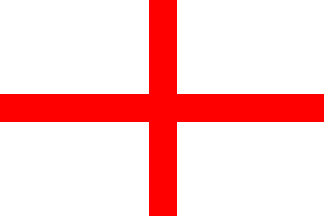

Last modified: 2019-07-30 by ivan sache
Keywords: peasants' war | boerenkrikg | cross (red) |
Links: FOTW homepage |
search |
disclaimer and copyright |
write us |
mirrors
Flag of the Peasant's War, 1798 (modern reconstitution) - Image by Ivan Sache, 2 June 2007
See also:
An uprising against the French ruler was planned by the "Brabantian
patriots", mostly nobles, civil servants, priests and monks from
Enunerich (Gelderland) and Rozendaal (North Brabant), supported by the
Stadhouder Willem V of Oranje (1748-1806), who expected the recreation
of the Netherlands (first for him, then for his son, later crowned as
Willem I, 1772-1843) and also by England, Prussian and Austria. The
beginning of the uprising was scheduled to 25 October 1798. On 24 September 1798,
the French rulers decided the conscription (draft) of all men aged 16
to 25 all over the Low Countries, which increased the farmers' wrath.
The arrest of an inhabitant of Overmere (Berlare) for outstanding tax caused a spontaneous uprising on 12 October, two weeks earlier than planned, by
the farmers (also called Brigands by the French).
The revolted farmers attempted to reach the mouth of the Scheldt, where
an English fleet was expected. Two attempts of landing failed, the
first on 21 October in Vlissingen and the second on 23-24 October in
Blankenberge. The farmers withdrew to Klein-Brabant (Boom).
In West Flanders, the rebellion was quickly suppressed after the battle of Ingelmunster, during which 200 were killed.
In South-East Flanders, Ronse and Oudenaarde were occupied by the insurgents, but the French
army pacified the whole region on 20 October. Mechelen was occupied on 22 October but lost two days later; forty-one insurgents were shot in
front of the St. Rombout tower.
In Klein-Brabant, the Brigands were initially very successful, and occupied the old St. Margriet fortress near the mouth of the Rupel. They resisted there more than 14 days, led
by Emmanuel Rollier, from Sint-Amands. Violent fightings took place
every day in Dendermonde, Boom, Lier, Willebroek and mostly Bornem,
which was burned on 5 November.
In Kempen, the uprising started on 15 October in Geel, led by Jozef Van Gansen, from Westerlo. The fightings
took place in Westerlo, Geel, Mol, the abbey of Tongerlo, Diest,
Turnhout and Herentals. After the fall of Herentals on 28 October, the farmers withdrew deeper into Kempen. In the Hageland, the uprising was let by Eelen, the son of a doctor from Scherpenheuvel. Zoutleeuw and Tienen were seized but the Brigands were eventually defeated in Leuven on 28 October.
After the battle of Bornem, Van Gansen led 10,000 Brigands in Geel,
3,000 in the Hageland and another 4,000 in Klein-Brabant. They had to
withdraw from Turnhout and Geel but won a limited victory in Meerhout
on 12 November. The same day, 6,000 Brigands took Diest by surprise,
but they were quickly expelled by the French troops. Van Gansen was
injured. On 14-15 November, the land surveyor Meulemans, from Tongerlo,
allowed the Brigands to withdraw nightly on a small dyke crossing
flooded fields along the Demer. Afterwards, the Brigands were split
into two groups: Eelen moved southwards, to Kortenaken, whereas the
printer Pieter Cobeels, from Turnhout, moved northwards, to Mol, with
the bigger group. On 22 November, a big battle in Mol caused the death
of 1,000. Corbeels and Meulemans were captured and brought triumphally
to Brussels via Antwerp.
Eelen still resisted because he knew better the region then the French and won a small victory in Tienen on 2 December. Along with Van Gansen, he moved to Hasselt with 4,000 men on 4 December, aiming at the citadel of Maastricht. Unfortunately, the
French troops were already in Hasselt, defending the three gates of the
town. The Brigands withdrew to Alken, but the group was split in
two. Those who could not have left the town were slaughtered and
several other were captured outside the town.
On 7 December, the French celebrated their victory in Brussels with a
torchlight procession. Hunders of Brigands were jailed and a dozen was
sentenced to death and shot or beheaded, like Corbeels and Meulemans,
beheaded on 21 June 1799 in Tournai. Eelen and Van Gansen, helped by Geert Heisen, the commander of the Brigands from Zoerle-Parwijs, carried on for months an unsuccessful
guerilla. An attempt of English landing in Den Helder in August 1799
was another failure. The peace was restored and the survivors of the
uprising hid.
Source: History of the Boerenkrijg, by Marc Alcide
Ivan Sache, 21 May 2007
No historical flag from the Peasants' War seems to have been preserved. The chapel of Hilst, where after the battle of Hasselt the remnant of the peasants was killed is decorated with a white flag with a red cross. In a barn nearby this event is commemorated every first Saturday of December, with the sam flag hanging on the wall.
The book De Boerenkrijg (1798), published in 1898 by the Davidsfonds in Leuven, shows a colour print (42 x 58 cm) entitled De strijd tussen de boeren en de Franschen (The fight between peasants and French). On the image, the flag has a thin red cross, not touching the edges of the flag; the staff of the flag is a pitchfork.
Jan Mertens, 2 June 2007